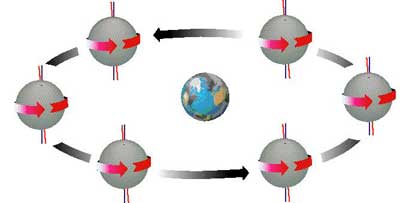Source: NASA
10-19-2007 11:35
 |
The moon rotates on its axis once every 29 1/2 days. That is the period from one sunrise to the next, as seen from the lunar surface, and so it is known as a lunar day. By contrast, Earth takes only 24 hours for one rotation.
The moon's axis of rotation, like that of Earth, is tilted. Astronomers measure axial tilt relative to a line perpendicular to the ecliptic plane, an imaginary surface through Earth's orbit around the sun. The tilt of Earth's axis is about 23.5 degrees from the perpendicular and accounts for the seasons on Earth. But the tilt of the moon's axis is only about 1.5 degrees, so the moon has no seasons.
Another result of the smallness of the moon's tilt is that certain large peaks near the poles are always in sunlight. In addition, the floors of some craters -- particularly near the south pole -- are always in shadow.
The moon completes one orbit of Earth with respect to the stars about every 27 1/3 days, a period known as a sidereal month. But the moon revolves around Earth once with respect to the sun in about 29 1/2 days, a period known as a synodic month. A sidereal month is slightly shorter than a synodic month because, as the moon revolves around Earth, Earth is revolving around the sun. The moon needs some extra time to "catch up" with Earth. If the moon started on its orbit from a spot between Earth and the sun, it would return to almost the same place in about 29 1/2 days.
A synodic month equals a lunar day. As a result, the moon shows the same hemisphere -- the near side -- to Earth at all times. The other hemisphere -- the far side -- is always turned away from Earth.
People sometimes mistakenly use the term dark side to refer to the far side. The moon does have a dark side -- it is the hemisphere that is turned away from the sun. The location of the dark side changes constantly, moving with the terminator, the dividing line between sunlight and dark.
The lunar orbit, like the orbit of Earth, is shaped like a slightly flattened circle. The distance between the center of Earth and the moon's center varies throughout each orbit. At perigee (PEHR uh jee), when the moon is closest to Earth, that distance is 225,740 miles (363,300 kilometers). At apogee (AP uh jee), the farthest position, the distance is 251,970 miles (405,500 kilometers). The moon's orbit is elliptical (oval-shaped).
Editor:Yang Jie
